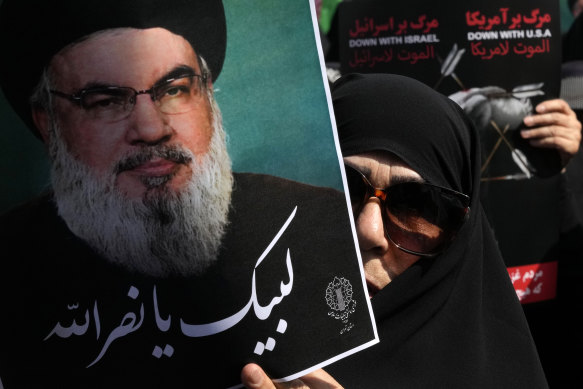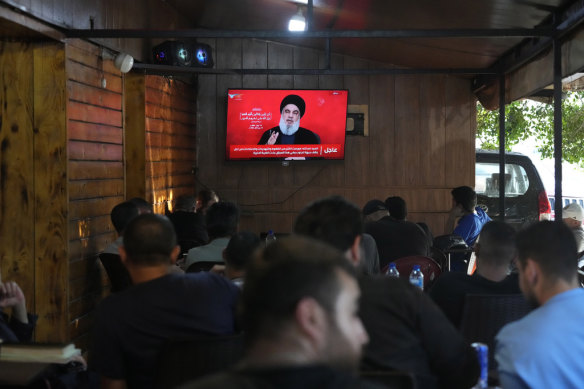Who was the messianic Hezbollah leader targeted by Israel?
By Bryan Pietsch
Hezbollah leader Sayyed Hassan Nasrallah, whose death was announced on Saturday, led the Lebanese group through decades of conflict with Israel, overseeing its transformation into a military force with regional sway and becoming one of the most prominent Arab figures in generations - with Iranian backing.
Hezbollah said in a statement that Nasrallah had been killed, but it did not say how. The 64-year-old’s death deals a huge blow to the group. He will be remembered among his supporters for standing up to Israel and defying the United States. To enemies, he was head of a terrorist organisation and a proxy for Iran’s Shiite Islamist theocracy in its tussle for influence in the Middle East.
Israel said earlier Nasrallah was the target of Israel’s latest strike in Lebanon.
The attack, a missile barrage that struck what the Israeli military described as Hezbollah’s central headquarters in a residential area in the southern suburbs of Beirut, levelled between four and six buildings, according to Lebanon’s Health Minister Firass Abiad. Plumes of smoke could be seen 50 kilometres away, and the explosion shook homes across the city.

An Iranian worshipper holds up a poster of Hezbollah leader Sayyed Hassan Nasrallah, reading in Arabic: “At your service Nasrallah” during an anti-Israeli rally after Friday prayers in Tehran, Iran.Credit: AP
Nasrallah had not been seen in person since the beginning of the 2006 war with Israel, eschewing any public appearances for video addresses out of fear of assassination. He had previously warned that “any assassination on Lebanese soil that targets a Lebanese, Palestinian, Syrian, Iranian or others will certainly have a strong reaction”.
Here is what to know about Nasrallah’s role in Hezbollah and his views on the Israel-Gaza war.

People watch a speech by Hezbollah leader Hassan Nasrallah on a TV screen in a cafe in the southern suburbs of Beirut last week.Credit: AP
Who is Hassan Nasrallah?
Nasrallah was born in Beirut in 1960. He studied to become a cleric at Shiite seminaries in Iran and Iraq.
He reportedly joined Hezbollah in the early 1980s, following the Israeli invasion of Lebanon in 1982. He became the leader of the group in 1992 after the assassination of his predecessor, Sayyed Abbas Musawi, by Israeli forces.
Nasrallah, 63, led Hezbollah for the latter half of the Israeli occupation of Lebanon, which lasted formally for 15 years at the end of the 20th century.
Though he was not technically a public official in Lebanon, Nasrallah was one of the country’s largest-looming political figures. Hezbollah and its allies lost the majority in parliamentary elections in 2022 but still hold the largest share of seats, in a time of economic crisis and widespread discontent.
Known for his long, bombastic speeches and a pronounced lisp, his followers called him “The Sayyed” or “Abu Hadi” – Arabic for Father of Hadi, his son who was killed in clashes with Israeli troops in 1997.
One of his most triumphant moments was during the month-long war that Hezbollah militants and Israel waged in 2006. Three days into the conflict, he was speaking on air with Hezbollah’s Al-Manar channel and said the surprises he had promised were about to begin. Then an Israeli warship was targeted.
“Watch it burn,” he said.
Walid Phares, a Lebanese-born political commentator, told the Council on Foreign Relations in 2010 that Nasrallah was seen among some in Lebanon as a “messianic figure”.
In a 2006 dispatch from Lebanon, analyst and author Robin Wright, then a Washington Post reporter who visited Nasrallah in Beirut, wrote that his face was displayed there on computer screen savers, posters and keychains. “Taxis play his speeches instead of music,” Wright reported.
What were his views?
A key goal of Hezbollah, according to its 1985 manifesto, is the destruction of Israel. Under Nasrallah, Hezbollah has continued to engage in skirmishes with Israel.
Though Hamas is Sunni and Hezbollah is Shiite, and the two militant groups have disagreed on other conflicts in the region, they have found common cause recently in opposing Israel; destroying Israel is also a stated aim of Hamas. Both groups have been classified as terrorist organisations by the United States, Australia, the UK and the European Union. Both receive support from Iran, experts and officials say.
The Israeli occupation of Lebanon appears to have been formative in Nasrallah’s motivations. He told Wright in 2006 that he and his peers had witnessed “what happened in Palestine, in the West Bank, in the Gaza Strip, in the Golan [Heights], in Sinai”.
That taught him that in Lebanon, “we cannot rely on the Arab League states, nor on the United Nations,” he said. “The only way that we have is to take up arms and fight the occupation forces.”
What did Nasrallah say about the Israel-Gaza war?
Since the war began on October 7, when Hamas attacked Israel, Hezbollah and Israel have traded fire near the Israel-Lebanon border. At first, both sides stayed within the boundaries of decades-understood rules of engagement. Over time, however, both sides’ attacks became more sophisticated, penetrating deeper into the other’s territory. The latest Israeli strikes on Lebanon are a dramatic escalation from the status quo.
In Nasrallah’s first public remarks on the Israel-Gaza war, he said that Hezbollah and other Hamas allies were unaware of the plans for the October 7 attack, but that Hamas had “no other choice” but to attack Israel. “The other choice,” he said, “would have been silence and death.”
In his speech, Nasrallah boasted that Hezbollah’s “daily, targeted” strikes against Israel were distracting and weakening it in its fight against Hamas. He warned Israel against any “aggression or preemptive strike” on Lebanon, which he said would be “the biggest idiocy in the history of your existence”.
Hezbollah’s fighting with Israel on the border, he said, “is a front of solidarity and support for Gaza”.
That front was evolving based on developments in Gaza, he said, adding that “all the options are on the table and we could go towards them at any point in time”.
In the face of almost a year of international ceasefire efforts, Nasrallah maintained in his speeches to the public – filmed from an unknown bunker – that he would continue the fight against Israel until there was a ceasefire in Gaza.
The Washington Post